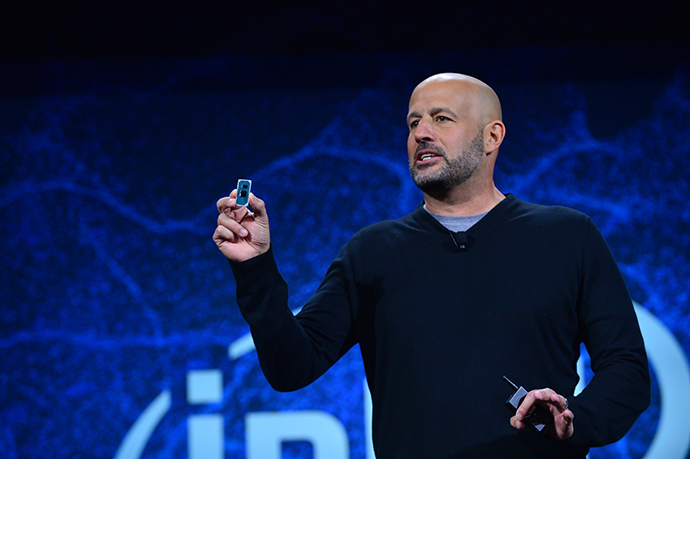 INFRA
INFRA
 INFRA
INFRA
 INFRA
INFRA
Intel Corp. took to the stage at the CES consumer electronics show in Las Vegas Monday in order to showcase its first central processing units built using its 10-nanometer process.
Dubbed Ice Lake, the processors for personal computers are based on Intel’s recently unveiled Sunny Cove microarchitecture, which makes use of instruction sets designed to push the use of artificial intelligence and Intel Gen 11 graphics.
Sunny Cove boosts the performance per clock and power efficiency of Intel’s chips for regular everyday computing. It also adds new features that will help give the silicon and edge in workloads related to AI and cryptography, the company said.
More specifically, Sunny Cove gives CPUs the ability to execute more operations in parallel, reduce latency through improved algorithms, and provide bigger buffers and caches to optimize data-centric workloads, Gregory Bryant (pictured), senior vice president of Intel’s Client Computing Group, said onstage.
The Ice Lake chips will also incorporate Thunderbolt 3, Wi-Fi 6 and Deep Learning boost for PCs and laptops once the first devices ship later in the year.
Ice Lake is an important milestone for Intel. It has fallen behind rivals such as Advanced Micro Devices Inc., which is now shipping CPUs built using a seven-nanometer process. That means AMD can squeeze greater numbers of transistors on each chip, thereby boosting compute power.
Intel had originally planned to launch its 10nm processors way back in 2016, but the company was beset by delays and most recently said they wouldn’t arrive until 2019 at the earliest. With Ice Lake, it seems Intel has finally delivered on its promise.
Intel further added to its chip lineup at CES with six new 9th Generation chips focused on video gaming PCs. The new chips, ranging from entry-level Core i3 all the way up to a new Core i9 processor, are set to ship later this month. The company also said it’s planning to bring its 9th Gen chips to its H-Series of processors for laptops, with a launch date scheduled for the second quarter of this year.
Looking to the future, Intel offered up a preview of a new hybrid CPU client platform called Lakefield that uses its Foveros 3D packaging technology. Lakefield CPUs come with five cores, consisting of one 10nm Sunny Cove core plus four Intel Atom-based cores, and help combine separate pieces of intellectual property into a single product with a smaller motherboard footprint. This will allow computer manufacturers “more flexibility for thin and light form factor design,” the company said.
Intel also announced a new innovation program called Project Athena that provides a set of industry specifications developed to help “usher in a new class of advanced laptops designed to enable new experiences and capitalize on next-generation technologies, including 5G and artificial intelligence.”
The specification outlines platform requirements to enable these new technologies, plus user experience and benchmarking targets defined by real world usage models, Intel said. The company expects the first devices built according to Project Athena specs to be launched in the latter half of this year.
With a specific focus on AI workloads, Intel detailed its new Nervana Neural Network Processor for Inference. This is a new class of chip that Intel said is designed to accelerate inference in AI training, or the speed at which AI models come to conclusions based on the data they’re presented with.
Patrick Moorhead, principal analyst at Moor Insights & Strategy, told SiliconANGLE that this was an important announcement because Intel claims NNP-I can outperform Nvidia Corp.’s graphics processing units in inference performance on real applications.
“If this stands true, it would be huge,” Moorhead said. “Intel seems very confident and I’m looking forward to seeing third party benchmarks on production cards running production workloads.”
Intel said the new chip, which is codenamed “Spring Crest,” will launch later this year.
Finally, Intel is expanding its system-on-chip ecosystem with a new 10nm-based platform called Snow Ridge, which is designed to enable 5G wireless access and edge computing workloads. The company said it’s intended to bring Intel architecture into wireless access base stations and allow more computing functions to be distributed to the network edge.
Support our mission to keep content open and free by engaging with theCUBE community. Join theCUBE’s Alumni Trust Network, where technology leaders connect, share intelligence and create opportunities.
Founded by tech visionaries John Furrier and Dave Vellante, SiliconANGLE Media has built a dynamic ecosystem of industry-leading digital media brands that reach 15+ million elite tech professionals. Our new proprietary theCUBE AI Video Cloud is breaking ground in audience interaction, leveraging theCUBEai.com neural network to help technology companies make data-driven decisions and stay at the forefront of industry conversations.